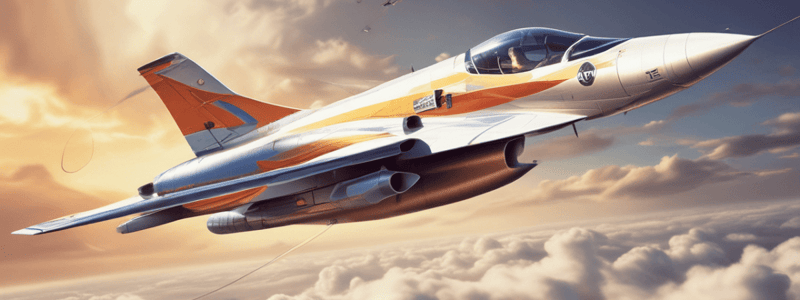Podcast
Questions and Answers
What type of engines are most affected by lower air density due to high ambient temperatures?
What type of engines are most affected by lower air density due to high ambient temperatures?
- Jet engines
- Turbocharged engines
- Turboshaft engines
- Naturally aspirated piston engines (correct)
What is a critical factor for pilots to consider when operating at high-altitude airports?
What is a critical factor for pilots to consider when operating at high-altitude airports?
- Wind direction
- Air pressure
- Humidity
- Ambient temperature (correct)
What adjustments must pilots make to compensate for high ambient temperatures during takeoff and landing?
What adjustments must pilots make to compensate for high ambient temperatures during takeoff and landing?
- Use a shorter runway
- Fly at a higher altitude
- Adjust expected takeoff roll, climb rate, and landing distances (correct)
- Increase aircraft weight
What is the term for an aircraft operating in conditions equivalent to a higher altitude due to high ambient temperatures?
What is the term for an aircraft operating in conditions equivalent to a higher altitude due to high ambient temperatures?
What is the primary reason pilots must consult performance charts in the AFM or POH?
What is the primary reason pilots must consult performance charts in the AFM or POH?
How do high ambient temperatures affect aircraft performance during takeoff and landing?
How do high ambient temperatures affect aircraft performance during takeoff and landing?
Why is it critical for pilots to understand the effects of ambient temperature on aircraft performance?
Why is it critical for pilots to understand the effects of ambient temperature on aircraft performance?
What happens to air density as ambient temperature increases?
What happens to air density as ambient temperature increases?
What is the purpose of consulting the Aircraft Flight Manual (AFM) or Pilot's Operating Handbook (POH)?
What is the purpose of consulting the Aircraft Flight Manual (AFM) or Pilot's Operating Handbook (POH)?
What is the consequence of not accounting for temperature variations during takeoff and landing?
What is the consequence of not accounting for temperature variations during takeoff and landing?
Aircraft performance during takeoff and landing is not affected by ambient temperature.
Aircraft performance during takeoff and landing is not affected by ambient temperature.
Turbocharged or turboshaft engines can compensate for the lower air density caused by high ambient temperatures.
Turbocharged or turboshaft engines can compensate for the lower air density caused by high ambient temperatures.
Pilots operating in high-altitude airports do not need to consider ambient temperature.
Pilots operating in high-altitude airports do not need to consider ambient temperature.
Performance charts in the AFM or POH provide corrections for air pressure only.
Performance charts in the AFM or POH provide corrections for air pressure only.
Density altitude effects only occur at high-altitude airports.
Density altitude effects only occur at high-altitude airports.
Pilots can ignore temperature variations when operating at sea level.
Pilots can ignore temperature variations when operating at sea level.
Aircraft performance is not affected by air density.
Aircraft performance is not affected by air density.
Pilots only need to consider temperature corrections during takeoff.
Pilots only need to consider temperature corrections during takeoff.
High ambient temperatures always result in a shorter takeoff roll.
High ambient temperatures always result in a shorter takeoff roll.
Pilots do not need to adjust their situational awareness due to density altitude effects.
Pilots do not need to adjust their situational awareness due to density altitude effects.
How do pilots operating in high-altitude airports need to be more vigilant, and what calculations do they need to conduct?
How do pilots operating in high-altitude airports need to be more vigilant, and what calculations do they need to conduct?
What is the significance of consulting performance charts in the AFM or POH, and what do these charts provide?
What is the significance of consulting performance charts in the AFM or POH, and what do these charts provide?
How does the phenomenon of density altitude affect aircraft performance, and what impact does it have on situational awareness?
How does the phenomenon of density altitude affect aircraft performance, and what impact does it have on situational awareness?
Why is it crucial for pilots to account for temperature variations during takeoff and landing, and what is the consequence of not doing so?
Why is it crucial for pilots to account for temperature variations during takeoff and landing, and what is the consequence of not doing so?
How does ambient temperature affect air density, and what is the impact on aircraft performance?
How does ambient temperature affect air density, and what is the impact on aircraft performance?
What is the relationship between air density and aircraft performance, and why is it essential to consider this relationship?
What is the relationship between air density and aircraft performance, and why is it essential to consider this relationship?
How do turbocharged or turboshaft engines differ from naturally aspirated piston engines in terms of compensating for lower air density?
How do turbocharged or turboshaft engines differ from naturally aspirated piston engines in terms of compensating for lower air density?
What is the primary concern for pilots operating in environments with high ambient temperatures, and how can they mitigate this concern?
What is the primary concern for pilots operating in environments with high ambient temperatures, and how can they mitigate this concern?
Why is it essential for pilots to understand the effects of ambient temperature on aircraft performance, and what is the consequence of not understanding these effects?
Why is it essential for pilots to understand the effects of ambient temperature on aircraft performance, and what is the consequence of not understanding these effects?
How does high ambient temperature affect the takeoff roll, climb rate, and landing distances of an aircraft, and what adjustments do pilots need to make?
How does high ambient temperature affect the takeoff roll, climb rate, and landing distances of an aircraft, and what adjustments do pilots need to make?
Flashcards are hidden until you start studying
Study Notes
Wind Effects on Aircraft Performance
- Headwind:
- Blows directly opposite to the direction of takeoff or landing
- Allows aircraft to achieve lift at lower ground speeds, reducing takeoff distance and enabling steeper climb
- Slows the airplane's speed over the ground during landing, contributing to shorter landing rollout
- Tailwind:
- Extends required runway length during takeoff
- Shallows climb angle, increasing risk of obstacle clearance issues
- Causes aircraft to approach at higher ground speed during landing, necessitating more runway to decelerate safely
- Crosswinds:
- Require adept skills to manage
- Techniques: angling the aircraft into the wind (crabbing) and sideslipping to maintain centerline during takeoff and landing
- Wind Shear:
- Sudden change in wind speed or direction over a short distance
- Modern aircraft equipped with wind shear detection systems providing vital alerts
- Best Practices for Compensating Wind Effects:
- Thorough pre-flight planning
- Constant observation of windsocks and tetrahedrons
- Active communication with air traffic control for wind updates
- Practicing crosswind techniques
Pressure Altitude Changes During Critical Phases of Flight
- Pressure Altitude:
- Altitude when ambient atmospheric pressure is referenced to standard atmosphere pressure of 29.92 inches of Hg (Mercury)
- Directly affects aircraft's lift, engine performance, and ability to take off and land safely
- Effects of Pressure Altitude Changes:
- Increase in pressure altitude:
- Longer takeoff roll and higher rotation speeds required due to lower air density
- Wings need to move faster to produce required lift
- High-pressure systems: present higher altitudes than actual
- Low-pressure systems: show lower altitudes on the altimeter
- Increase in pressure altitude:
- Practical Tips:
- Anticipate increased power settings may be required to compensate for reduced air density and loss of lift during high pressure altitude conditions
- Ensure airspeed indications are accurate, as true airspeed will be higher than indicated during these phases
- Case Scenario: High-Altitude Airport Takeoff
- Elevated temperature combined with airport's altitude results in high pressure altitude
- Aircraft must accelerate to higher-than-usual speed to achieve required lift
- Failing to consider this could result in underestimating runway required for safe takeoff
- Effects on Engine Performance:
- Decrease in air density: engine may produce less thrust
- Requires careful monitoring of power settings to maintain optimal performance
- Pre-Flight and In-Flight Checks:
- Refer to Aircraft Flight Manual for guidance on adjusting for pressure altitude
- Incorporate knowledge into flight planning for enhanced safety
- Conclusion:
- Recognizing pressure altitude's impact on aircraft performance and preparing for it allows pilots to maintain control and ensure safety of flight operations
Wind Effects on Aircraft Performance
- A headwind can be beneficial during takeoff and landing, allowing the aircraft to achieve lift at lower ground speeds, reducing takeoff distance, and enabling a steeper climb
- A headwind during landing slows the airplane's speed over the ground, contributing to a shorter landing rollout
- A tailwind during takeoff extends the required runway length and shallows the climb angle, increasing the risk of obstacle clearance issues
- A tailwind during landing causes the aircraft to approach at a higher ground speed, necessitating more runway to decelerate safely
- Crosswinds require adept skill to manage, involving techniques like angling the aircraft into the wind (crabbing) and sideslipping to maintain the centerline
- Wind shear, a sudden change in wind speed or direction over a short distance, must be monitored, and modern aircraft are equipped with wind shear detection systems
Pressure Altitude and Aircraft Performance
- Pressure altitude is the altitude when the ambient atmospheric pressure is referenced to the standard atmosphere pressure of 29.92 inches of Hg (Mercury)
- Pressure altitude directly affects an aircraft's lift, engine performance, and ability to take off and land safely
- Weather systems and changing altitude levels can significantly alter pressure conditions, with high-pressure systems presenting higher altitudes and low-pressure systems showing lower altitudes
- Pressure changes affect air density, which in turn affects lift, requiring adjustments in takeoff and landing strategies
- Increased power settings may be required to compensate for reduced air density and loss of lift during high-pressure altitude conditions
- Airspeed indications must be accurate, as true airspeed will be higher than indicated during high-pressure altitude conditions
Case Scenario: High-Altitude Airport Takeoff
- At high-altitude airports, high pressure altitude conditions can result in reduced air density, requiring the aircraft to accelerate to a higher-than-usual speed to achieve the needed lift
- Failing to consider this could result in underestimating the runway required for safe takeoff, putting pilots and passengers at risk
Pressure Altitude Effects on Engine Performance
- Decreased air density affects engine performance, with the engine producing less thrust
- Careful monitoring of power settings is required to maintain optimal performance during takeoff and landing
- Pilots must refer to the Aircraft Flight Manual for guidance on adjusting for pressure altitude during pre-flight and in-flight checks
Ambient Temperature and Aircraft Performance
- Ambient temperature significantly impacts aircraft performance, particularly during takeoff and landing
- As temperature increases, air density decreases, affecting engine thrust, lift generated by the wings, and ultimately the aircraft's performance
- Higher ambient temperatures require a longer distance to take off and achieve the necessary climb rate
- Similarly, during landing, higher ambient temperatures can lead to longer landing roll distances as the aircraft needs more runway to decelerate adequately
- Engine performance is also impacted by temperature, with most engines relying on oxygen content in the atmosphere to burn fuel efficiently
Wind Effects on Aircraft Performance
- A headwind can be beneficial, allowing the aircraft to achieve lift at lower ground speeds, reducing takeoff distance, and enabling a steeper climb.
- During landing, a headwind slows the airplane's speed over the ground, contributing to a shorter landing rollout.
- A tailwind during takeoff extends the required runway length and shallows the climb angle, increasing the risk of obstacle clearance issues.
- When landing, a tailwind causes the aircraft to approach at a higher ground speed, necessitating more runway to decelerate safely.
- Crosswinds require adept skill to manage, and pilots use techniques such as crabbing and sideslipping to maintain the centerline during takeoff and landing.
- Wind shear is a sudden change in wind speed or direction over a short distance, and modern aircraft are equipped with wind shear detection systems to provide vital alerts.
Best Practices for Compensating Wind Effects
- Thorough pre-flight planning
- Constant observation of windsocks and tetrahedrons
- Active communication with air traffic control for wind updates
- Practicing crosswind techniques
Pressure Altitude Changes During Critical Phases
- Pressure altitude is an essential parameter in aviation, affecting lift, engine performance, and ultimately, the aircraft's ability to take off and land safely.
- Weather systems and changing altitude levels can significantly alter pressure conditions.
- High-pressure systems generally present higher altitudes than actual, while low-pressure systems show lower altitudes on the altimeter.
- Pressure changes affect air density, which directly influences lift.
- During takeoff, an increase in pressure altitude requires a longer takeoff roll and higher rotation speeds due to lower air density.
Ambient Temperature Effects on Performance
- Ambient temperature plays a crucial role in aircraft performance, particularly during takeoff and landing.
- As temperature increases, air density decreases, affecting engine thrust, lift generated by the wings, and ultimately the aircraft's performance.
- At higher temperatures, the aircraft will require a longer distance to take off and achieve the necessary climb rate.
- During landing, higher ambient temperatures can lead to longer landing roll distances.
- Engine performance is also impacted by temperature, with most engines relying on oxygen content in the atmosphere to burn fuel efficiently.
- Pilots must consult the performance charts in the Aircraft Flight Manual (AFM) or Pilot's Operating Handbook (POH) that provide corrections for temperature.
Studying That Suits You
Use AI to generate personalized quizzes and flashcards to suit your learning preferences.




